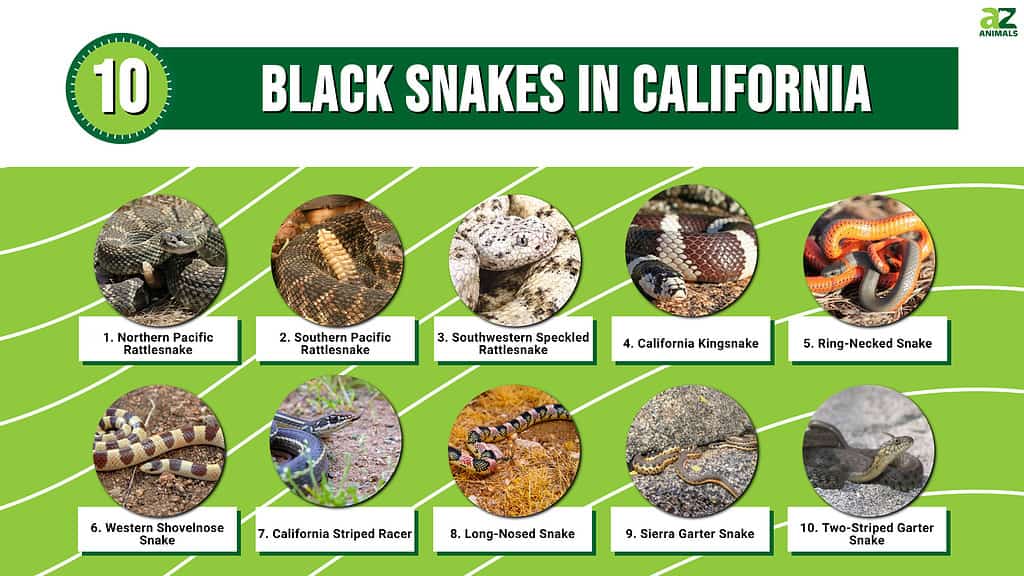
California is a state in the United States that is known for its sunny climate, large size, and diverse ecosystems. This state has a lot of wildlife, including several different kinds of snakes. While some of California’s snakes are dangerous because they have venom, most snakes in the Golden State are harmless to humans. Of course, seeing a black snake while you’re enjoying California’s coastlines and mountains still might startle you, and you may wonder just how dangerous it is. This article will help you to identify the black snakes in California so you can enjoy spending time in the great outdoors.
1. Northern Pacific Rattlesnake (Crotalus oreganus oreganus)
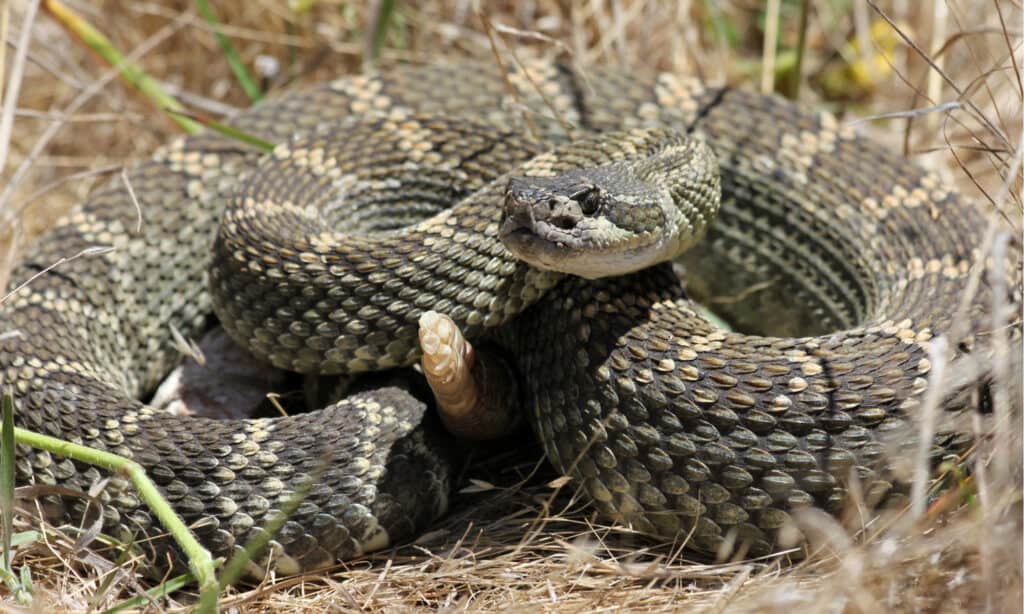
Northern Pacific rattlesnakes are venomous but luckily they are not particularly aggressive
©Ryan M. Bolton/Shutterstock.com
One of the most dangerous black snakes in California is the Northern Pacific rattlesnake. Northern Pacific rattlesnakes are venomous snakes that live in Northern and Central California. They can be active during the day, although when it gets really hot during the summer, they become nocturnal and crepuscular. These snakes typically live on rocky hillsides and outcroppings, talus slopes, rocky areas near streams, or rocky and forested areas. If you are ever bitten by a Northern Pacific rattlesnake, it is important to seek medical attention as soon as possible.
However, Northern Pacific rattlesnakes are not aggressive snakes. They are generally passive and will leave you alone as long as you leave them alone. They have heavy bodies and can be black, gray, tan, or brown, with large dark blotches on their backs. Northern Pacific rattlesnakes are pit vipers with large triangular heads, and segmented keratin rattles at the end of their tails. It’s important to keep your eyes peeled when you are outside in California, as not all rattlesnakes will rattle a warning – many snakes try to stay hidden, and if you’re not careful, you could accidentally step on one!
2. Southern Pacific Rattlesnake (Crotalus helleri)
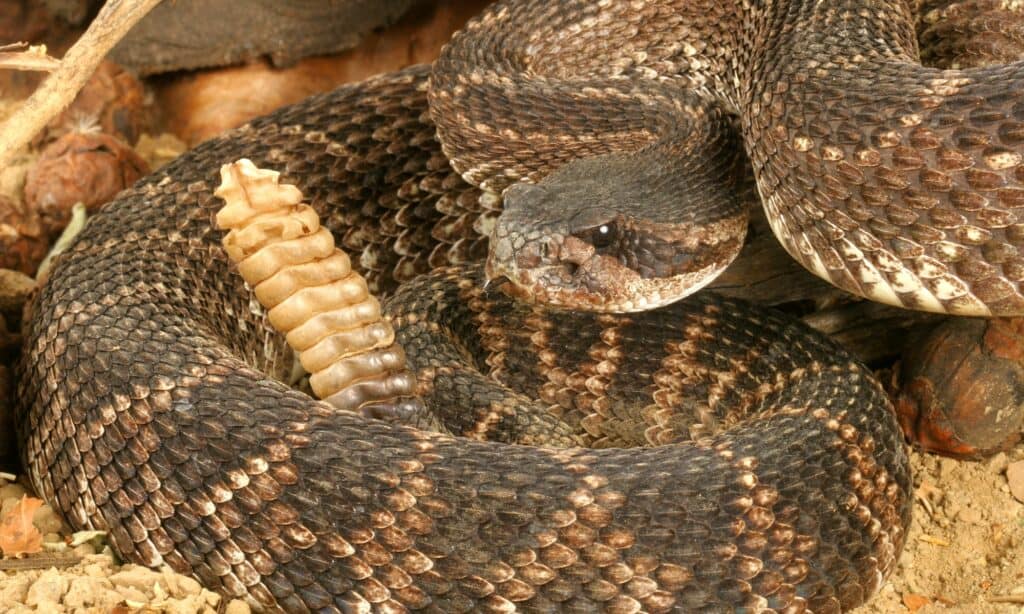
Southern Pacific rattlesnakes are highly venomous and difficult to spot as they often blend into their environment.
©iStock.com/johnaudrey
Also known as the black diamond rattlesnake, the Southern Pacific rattlesnake lives in Southwestern California. These snakes are not super picky when it comes to their habitat and may be seen anywhere from agricultural areas to open woodlands, seaside dunes, rocky hillsides, or grassy plains. They are venomous pit vipers with potent neurotoxins and should be avoided and left alone if ever happen to see them.
Southern Pacific rattlesnakes are often gray, olive-brown, brown, yellowish-brown, or almost black. It depends on where the snakes live, as their colors and patterns help them to blend into their environment. They have dark blotches with black outlines running down the middle of their backs with light-colored strips. The blotches are shaped like dark diamonds and turn into stripes near the end of the snake’s tail. Southern Pacific rattlesnakes usually grow between 30-44 inches long.
3. Southwestern Speckled Rattlesnake (Crotalus mitchellii pyrrhus)

Southwestern speckled rattlesnakes have many speckles across their body which gives them a distinctive appearance.
©iStock.com/reptiles4all
The southwestern speckled rattlesnake is a venomous pit viper that lives in most of Southern California. These snakes grow between 24-42 inches long on average and often live in rocky areas with lots of boulders. They commonly live in habitats with buttes, desert outcroppings, mesas, sagebrush, chaparral, thornscrub, creosote, and pinon-juniper woodlands, as well as succulent deserts and areas with loose soil.
Like their name, these snakes have a multitude of colored speckles all across their bodies, in addition to small, darker bands along their backs. Their colors and patterns offer excellent camouflage and help speckled rattlesnakes to blend in with their surroundings. Because of this, speckled rattlesnakes come in an endless variety of different colors like white, gray, pink, tan, orange, and yellow. Snakes that live in areas with lava beds actually can be almost entirely black, since that is the main color of their surrounding environment. Others in dark rocky areas will also have more dark speckling, giving their bodies a darker appearance.
4. California Kingsnake (Lampropeltis californiae)

California Kingsnakes (Lampropeltis californiae) are called kingsnakes because they sometimes eat other snakes.
©Creeping Things/Shutterstock.com
Found all over the state, the California kingsnake is a beautiful snake with bold black patterns. There are many different morphs throughout the state, although the most common are snakes with dark brown or black bands with light yellow or white bands that alternate down the length of the snake’s body. However, these patterns can vary quite a bit, and some snakes have long black and white stripes like garter snakes, while others may be solid in color or have speckling patterns.
California kingsnakes can grow between 36-54 inches, although in California they are rarely longer than 48 inches. When they feel threatened, they often vibrate the tips of their tails, mimicking rattlesnakes. These are great snakes to have around, not only because of their beautiful colors and patterns but because they can even eat venomous snakes like rattlesnakes! In California these snakes can be found in just about every habitat, even urban areas with large human populations.
5. Ring-Necked Snake (Diadophis punctatus)
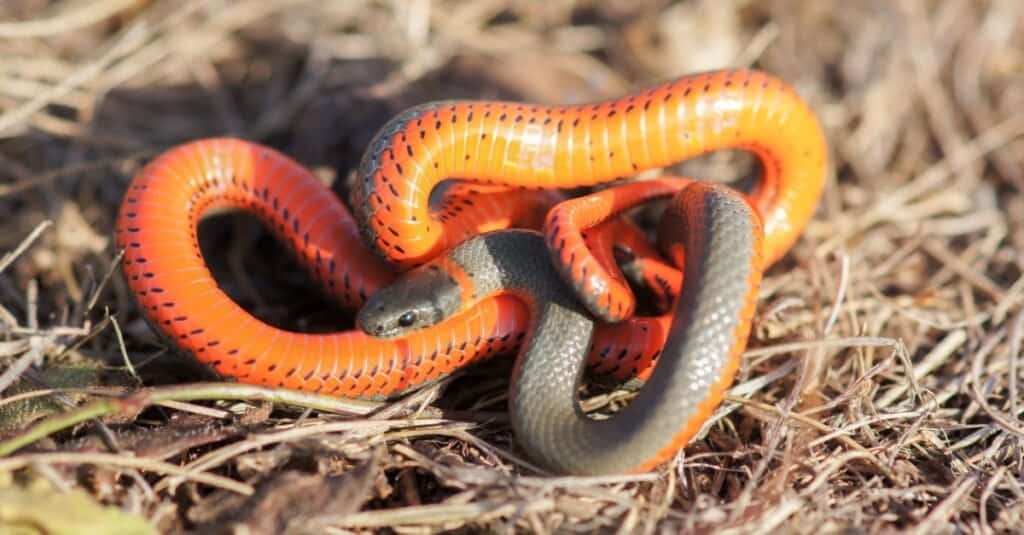
Small and colorful, the ring-necked snake is nocturnal and non-venomous.
©yhelfman/Shutterstock.com
One of California’s smaller black snakes is the ring-necked snake, which grows between 10-20 inches long. These nocturnal snakes are shy, secretive, and fast, so you likely won’t see them in the wild. They mainly live along the western coast of California in moist forests, marshes, and on hillsides. They do have mild venom, but their fangs are in the back of the mouth, so they are not harmful to humans. Ring-necked snakes eat small frogs, salamanders, worms, slugs, and lizards.
Ring-necked snakes have thin bodies with smooth scales. They are dark olive, black, blue-gray, or gray in color, with a bright orange ring around their necks. Their bellies are also bright orange or reddish, with tiny black speckles or spots.
6. Western Shovelnose Snake (Chionactis occipitalis)
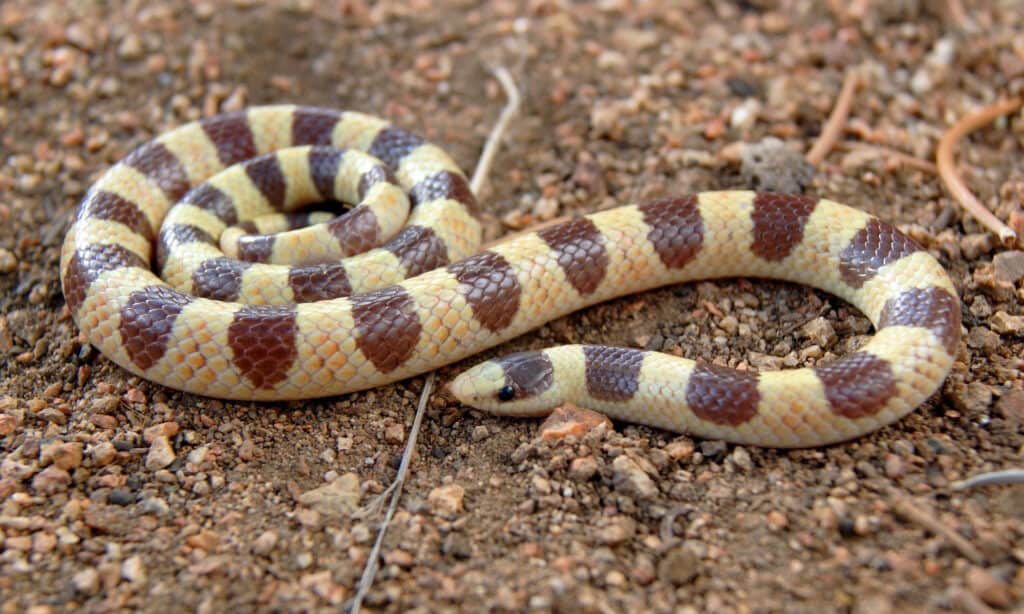
Western shovelnose snakes are small and have a distinctly flattened snout.
©Matt Jeppson/Shutterstock.com
Similar to the ring-necked snake, California’s Western shovelnose snakes are quite small, growing between 10-17 inches in length. However, these snakes only live in desert habitats with loose sand and sparse vegetation. They have a uniquely flattened snout shaped like a shovel that they use to dig, and sometimes bury their bodies in the sand.
Western shovelnose snakes live in southeastern California and hunt moths, centipedes, scorpions, spiders, and insects. Their bodies are white, cream, or yellow, with thick and bold black or dark brown saddles along their backs. Occasionally some snakes may have additional orange or red coloring in between these dark saddles, but it is not as common.
7. California Striped Racer or Whipsnake (Coluber lateralis lateralis)
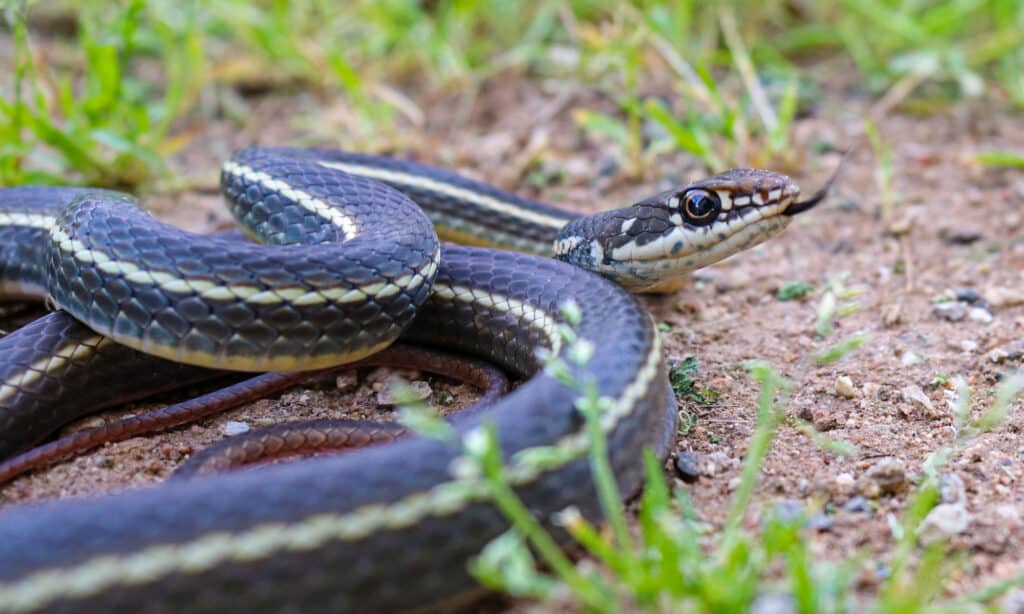
Striped racers are an aggressive snake species.
©Creeping Things/Shutterstock.com
These fast-moving snakes live along the west coast and in the central regions of California. If they feel like they are in danger, striped racers will first attempt to flee. However, if they are harassed or handled, they will repeatedly strike and violently bite, so it is best to leave these snakes alone. Striped racers are typically between 30-48 inches in length, although occasionally you might see a snake reach up to 60 inches in length. They have long, thin bodies with broad and elongated heads. Their bodies are black, dark olive, or gray, with a very thin, light-colored stripe that runs along each side of their bodies.
Striped racers live in habitats with open woodlands, canyons, brushy chaparral, rocky hillsides, scrub, stream, and pond edges, and desert riparian corridors. They eat lizards (especially spiny lizards), as well as small rodents, frogs, small birds, salamanders, and small snakes.
8. Long-Nosed Snake (Rhinocheilus lecontei)
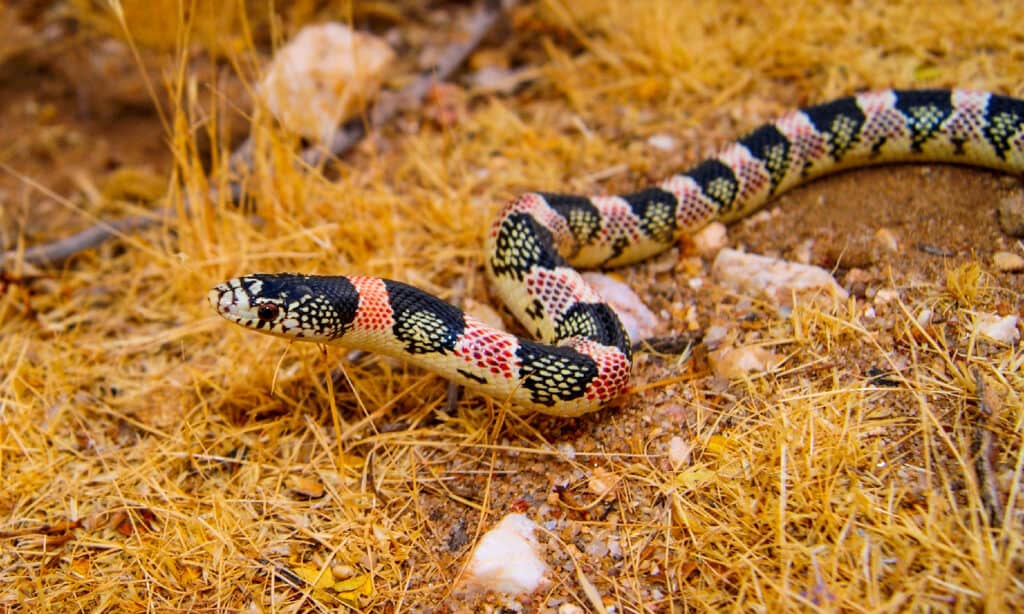
Long-nosed snakes are nocturnal and spend most of their lives underground.
©Matt Jeppson/Shutterstock.com
It is not common to see a long-nosed snake during the day, although it does happen occasionally. Long-nosed snakes spend much of their time underground and are very good at burrowing. They live in dry desert regions of southern California, as well as prairies, shrublands, and grasslands. Long-nosed snakes are relatively cold-tolerant and mostly eat lizards. They particularly like eating whiptail lizards but also occasionally hunt small snakes, nestling birds, and small mammals.
Long-nosed snakes are harmless snakes with slender bodies, usually between 16-30 inches long. Their bodies are white, but they look dark in color due to heavy red and black speckling. There are bold black and red alternating saddles that run down their backs, although some snakes in California do not have any red coloring.
9. Sierra Garter Snake (Thamnophis couchii)
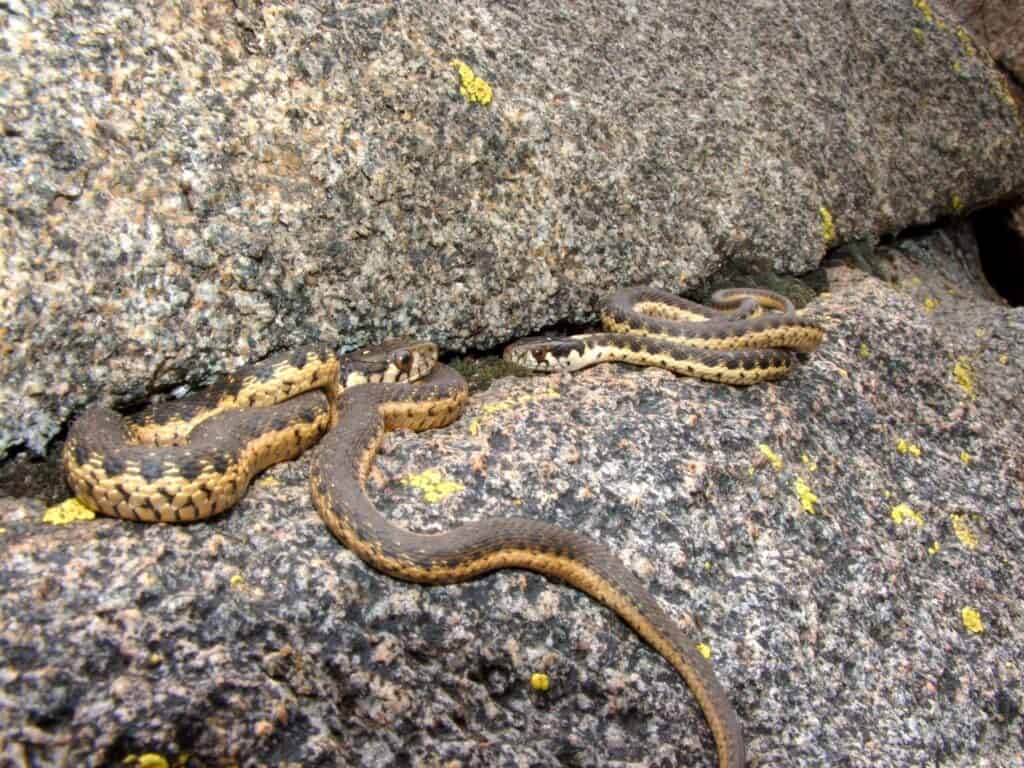
Sierra garter snakes spend a lot of their lives in water
©Matt Jeppson/Shutterstock.com
There are a number of garter snakes living in California, and many of them are black, like the Sierra garter snake. Like other garter snakes, Sierra garter snakes do produce mild venom to help with taking down small prey, but they are generally harmless to humans. These snakes live in the east-central regions of California in areas with water. They commonly live along rivers, ponds, lakes, and creeks, as well as oak woodlands and montane coniferous forests. Although all garters like water, Sierra garter snakes are even more aquatic than most. These water-loving snakes can crawl on the bottoms of streams and enjoy basking on floating vegetation or along the edge of the water.
Sierra garter snakes grow between 18-38 inches in length, with slender bodies and narrow snouts. Their bodies are black, dark brown, or olive brown, with dark blotches along their sides and backs. Some snakes have an additional light-colored stripe along the back, but it is usually only visible on the snake’s neck. Others may also have light-colored lateral stripes on their sides. In the northern regions of their range, Sierra garter snakes have black mottling as well. There is even a melanistic population in Plum Creek, Tehama County, where many snakes are entirely black!
10. Two-Striped Garter Snake (Thamnophis hammondii)

Two-striped garter snakes are highly aquatic and mainly live near water sources
©Jason Mints/Shutterstock.com
Another highly aquatic garter snake is the two-striped garter snake, which generally lives near water sources like cattle tanks, creeks, and pools. These snakes live along the southwestern coast of California, often in areas with sparse pine, scrub oak, brushland, willow, and coastal sage scrub. They are primarily aquatic snakes that eat fish and their eggs, small frogs, tadpoles, leeches, newt larvae, and earthworms.
Two-striped garter snakes can grow between 24-40 inches long, but the snakes in California are usually 18-30 inches. They come in a range of colors and patterns, although there are two main morphs seen in the state: spotted snakes or striped snakes. Striped snakes have a gray or yellowish stripe running along each side of their bodies, while spotted snakes have two rows of small dark dots. Some snakes have dots in addition to lateral stripes, while others do not have any stripes at all. Both morphs are olive, dark gray, brown, or black with a partial dorsal stripe on the back of their necks. Many black snakes have been seen in San Luis Obispo County, as well as in Monterey Bay to Santa Barbara County. There is also a melanistic population of two-striped garter snakes living on Catalina Island.
Summary of 10 Black Snakes in California
| # | Snake | Length |
|---|---|---|
| 1 | Northern Pacific Rattlesnake | 36 – 60 inches |
| 2 | Southern Pacific Rattlesnake | 33 – 44 inches |
| 3 | Southwestern Speckled Rattlesnake | 24 – 32 inches |
| 4 | California Kingsnake | 36 – 54 inches |
| 5 | Ring-Necked Snake | 10 – 20 inches |
| 6 | Western Shovelnose Snake | 10 – 17 inches |
| 7 | California Striped Racer or Whipsnake | 30 – 60 inches |
| 8 | Long-Nosed Snake | 16 – 30 inches |
| 9 | Sierra Garter Snake | 18 – 38 inches |
| 10 | Two-Striped Garter Snake | 24 – 40 inches |
The photo featured at the top of this post is © Creeping Things/Shutterstock.com
Discover the "Monster" Snake 5X Bigger than an Anaconda
Every day A-Z Animals sends out some of the most incredible facts in the world from our free newsletter. Want to discover the 10 most beautiful snakes in the world, a "snake island" where you're never more than 3 feet from danger, or a "monster" snake 5X larger than an anaconda? Then sign up right now and you'll start receiving our daily newsletter absolutely free.
Sources
- Desert Museum, Available here: https://www.desertmuseum.org/books/nhsd_shovelnose_snake.php
- California Herps, Available here: https://californiaherps.com/info/findsnakes.html
Thank you for reading! Have some feedback for us? Contact the AZ Animals editorial team.






